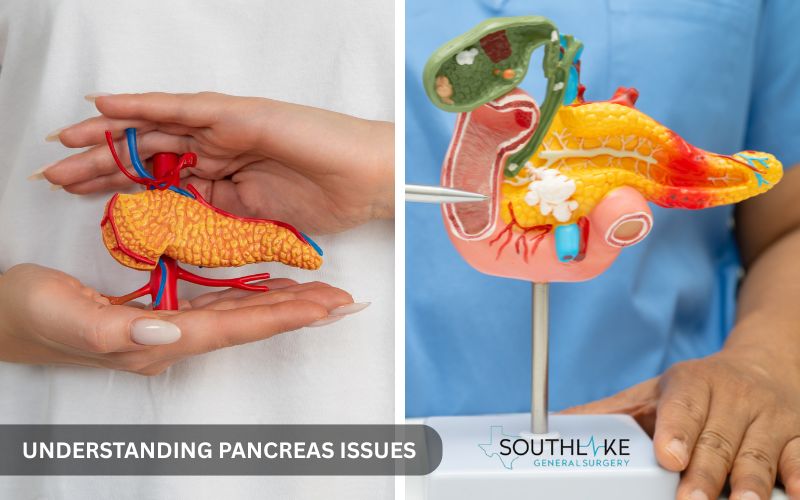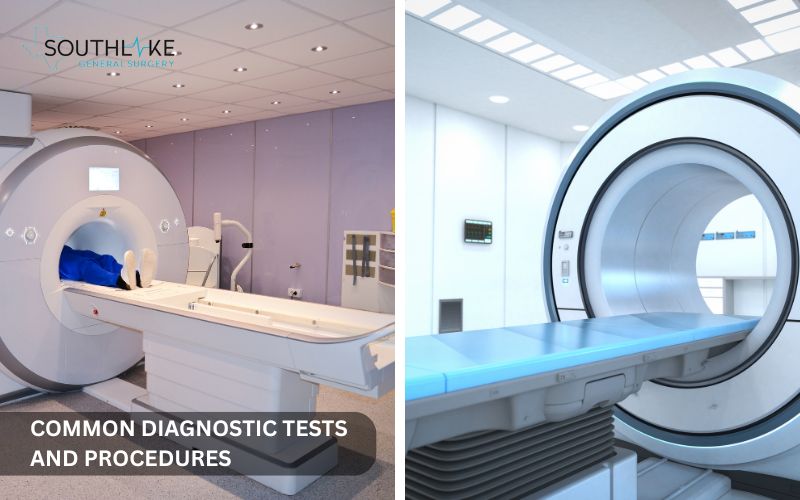Pancreas issues are serious and affect many people around the world. The pancreas is key for digestion and for controlling blood sugar levels. This makes it essential for good health.
It’s important to spot these issues early and know more about them for proper care. With tests, scans, and personalized treatment plans, people with pancreas problems can manage their health more effectively.
Key Highlights
- The pancreas is important for breaking down food and managing blood sugar. It makes enzymes and hormones.
- Conditions like pancreatitis, pancreatic cancer, and diabetes can hurt the pancreas.
- It is important to look for early signs of pancreas problems. These signs may be abdominal pain, nausea, and changes in bowel movements.
- Doctors usually use imaging tests like MRI and CT scans, blood tests, and sometimes ERCP to find pancreas issues.
- Treatment for pancreas problems can change depending on the problem and how serious it is. It may include changes in lifestyle, medicines, or surgery.
Understanding Pancreas Issues

The pancreas is found deep inside the abdomen. It is very important for our health. The pancreas has two main roles. It helps with digestion and also controls blood sugar levels. However, like any part of our body, the pancreas can get sick. Many diseases can affect the pancreas and change how it works.
When the pancreas is swollen or not functioning well, it can cause various health problems. Recognizing the early signs is really important. Getting medical help quickly can really improve how we manage and treat any issues with the pancreas.
What is the function of the pancreas?
The pancreas plays a key role in digestion and hormones. It generates enzymes that help in digestion, including amylase, lipase, and protease. These enzymes are essential for breaking down fats, proteins, and carbohydrates in the small intestine. By doing this, the body can absorb nutrients from food more effectively.
The pancreas is important for digestion. It also makes hormones, including insulin. These hormones are released into the bloodstream. Insulin is essential for managing blood sugar levels effectively. It helps cells absorb glucose from the blood. This process prevents blood sugar from rising too high.
If the pancreas doesn’t produce enough enzymes or hormones, it can lead to serious health problems. That’s why it’s important to keep the pancreas healthy for your overall well-being.
Common diseases affecting the pancreas

Many diseases can impact the pancreas. One such disease is pancreatitis. This disease causes inflammation of the pancreas. Pancreatitis can be classified into two categories: acute pancreatitis and chronic pancreatitis.
Acute pancreatitis happens quickly and lasts for a short time. On the other hand, chronic pancreatitis persists over an extended period. Acute pancreatitis usually gets better with treatment.
However, chronic pancreatitis can cause lasting damage. This damage affects how the pancreas makes digestive enzymes and insulin.
Pancreatic cancer poses a significant challenge, yet it occurs less frequently than pancreatitis. At first, this cancer usually does not show any signs. This makes it hard to detect early. When signs do show up, they can be confusing. Possible indications could involve pain in the abdomen, weight loss, and a yellowing of the skin or eyes (jaundice).
Diabetes affects the pancreas. In Type 1 diabetes, the pancreas doesn’t make enough insulin. Type 2 diabetes happens when the body doesn’t respond well to insulin. Both of these conditions can lead to elevated blood sugar levels. Without proper care, high blood sugar can lead to several health problems.
Early Signs and Symptoms of Pancreas Problems
The pancreas is very important for our body. It is found deep in the abdomen, which makes it hard to spot problems early. It’s crucial to know the warning signs. This is how any issues can be discovered and treated quickly. Often, these symptoms are mild. This makes some people think they are not serious.
You should watch for symptoms like pain in your upper abdomen, especially after eating. Notice if you feel ongoing nausea or vomiting. Unplanned weight loss and changes in your bowel habits, like fatty stools, are important too. Do not ignore these signs. Receiving timely medical assistance can significantly impact your health outcomes.
Recognizing the early signs of pancreas illness

Finding problems with the pancreas early is very important. If you ignore the first signs, it could cause serious complications. A common early sign is abdominal pain. This pain usually comes across as a dull ache. It can also move to your back. It may get worse after eating, especially when you have a fatty meal.
A person who has abdominal pain may feel unwell and might throw up. They could also stop wanting to eat and lose weight quickly without clear reasons. These problems can happen if the pancreas does not make enough digestive enzymes. When the body lacks these enzymes, digesting food becomes more difficult.
If the pancreas does not make enough insulin, it can lead to high glucose levels and various symptoms. You might feel extremely thirsty, need to go to the bathroom frequently, have blurry vision, and notice sores that take time to heal. It is important to spot these signs early. Identifying them can assist you in obtaining timely medical assistance.
Symptoms specific to acute and chronic pancreatitis
The signs of acute pancreatitis show up fast and can feel very strong. A key sign is severe abdominal pain. This pain can feel sharp or burning, and it may spread to your back. It often feels worse when you lie down and better when you lean forward. Other signs of acute pancreatitis are:
- Feeling sick and throwing up
- A high temperature
- A fast heartbeat
- Belly pain
Chronic pancreatitis happens slowly and lasts a long time. It is like acute pancreatitis, but the symptoms are usually milder and may come and go.
A common sign is pain in the upper abdomen, especially after you eat. As chronic pancreatitis gets worse, it can cause scarring and damage to the pancreas. This damage affects how well the pancreas produces digestive juices.
- Losing weight
- Steatorrhea (this is when stools are fatty and smell bad)
- Not getting enough nutrition
Causes of Pancreatic Diseases
Pancreatic diseases can occur for several reasons. Some of these reasons are genetics, lifestyle choices, and environmental factors. The primary factors leading to pancreatitis are excessive alcohol consumption and the presence of gallstones. There are also many other causes of pancreatitis that can impact the pancreas.
These factors can be genetic risks, certain medications, infections, and health problems such as cystic fibrosis and autoimmune diseases. It is important to identify these issues. This helps us understand how pancreatic diseases start and change over time.
Genetic and environmental factors
Genetic traits can play a big role in some diseases of the pancreas. If someone in your family has had pancreatitis or pancreatic cancer, you might have a higher risk for these diseases. Some changes in genes are linked to hereditary pancreatitis and increase the chance of getting pancreatic cancer.
Environmental factors can lead to problems with the pancreas. Being near harmful things, such as those found in pesticides and industrial cleaners, can raise the risk of pancreatic cancer.
Additionally, long-term viral infections, like chronic hepatitis B and C, can cause inflammation of the pancreas. This inflammation can increase the chances of getting pancreatitis and pancreatic cancer.
Your lifestyle choices have a big impact on the health of your pancreas. Smoking, drinking too much alcohol, and eating lots of processed foods or unhealthy fats can increase your risk of pancreatitis and pancreatic cancer. However, maintaining a healthy weight, eating nutritious foods, and exercising regularly can help reduce these risks.
Lifestyle contributions to pancreas health
Having a healthy lifestyle is important for your pancreas and overall health. Heavy alcohol use is a major risk factor for pancreatitis. It can cause inflammation and harm to the pancreas. To protect your pancreas, it is essential to cut back on alcohol use or stop drinking completely.
Smoking is a big risk factor for pancreatitis and pancreatic cancer. It can harm the pancreas in many ways. This damage can lead to more inflammation and help cancer cells grow. Quitting smoking is one of the best things you can do for your pancreas and your health.
Good nutrition is very important for a healthy pancreas. A balanced diet that includes fruits, vegetables, and whole grains provides essential nutrients. This type of diet also reduces stress on the pancreas. Eating less processed food, sugary drinks, and saturated fats helps keep the pancreas healthy. This can help prevent inflammation and damage.
Diagnosing Pancreas Issues
To find out if there are any problems with your pancreas, doctors typically review your medical history. They will conduct a physical examination and carry out several tests.
They will check for symptoms and ask if anyone in your family has had pancreas issues. Following that, they will arrange assessments to gain further insights into the condition of your pancreas.
Common diagnostic tests and procedures

Pancreatic tests and procedures help find problems accurately.
- Imaging tests such as CT scans and MRIs deliver precise visuals. They quickly show issues in the pancreas.
- Blood tests evaluate the concentrations of pancreatic enzymes. This test helps diagnose pancreatitis.
- A procedure called endoscopic retrograde cholangiopancreatography (ERCP) uses a camera to look at the pancreas and bile ducts. This can help find blockages or other problems.
- Ultrasounds are used to check the health of the gallbladder and pancreas.
These steps are important for diagnosing gallstones. When these tests are combined with a thorough review of medical history, they lead to the right diagnoses for pancreatic issues.
The role of imaging and blood tests
Imaging tests and blood tests play a big role in finding and tracking issues with the pancreas. An ultrasound is a reliable examination that employs sound waves. This creates images of the pancreas. The picture shows the pancreatic form and size. It can also reveal if there are gallstones or any blockages in the pancreatic duct.
Blood tests provide important details about the pancreas. High amounts of pancreatic enzymes, such as amylase and lipase, might indicate pancreatitis. Unusual blood sugar levels can lead to diabetes or problems with insulin. These assessments also evaluate indicators of inflammation, supporting physicians in identifying problems.
Imaging tests and blood tests assist physicians in assessing the condition of the pancreas. This information allows them to choose the best treatment for various issues related to the pancreas.
Treatment Options for Pancreatic Diseases

Treatment for pancreas issues can vary greatly. It depends on the specific issue, how serious it is, and the person’s overall health. Initially, the treatment usually focuses on stabilizing the patient and providing support, mainly when dealing with acute pancreatitis.
Doctors often suggest taking medicine to help with pain, reduce inflammation, and manage blood sugar levels. It’s also important to change some habits.
This means eating less fat and staying away from alcohol. These steps are important to keep the pancreas healthy and to avoid more complications.
Medical treatments and interventions
Medical treatments are often the first way to handle problems with the pancreas. When a person experiences acute pancreatitis, it’s common for them to require hospitalization. While there, patients get intravenous fluids, pain relief, and help with nutrition. If an infection happens, it’s common for doctors to prescribe antibiotics to help treat it.
Dealing with chronic pancreatitis needs different approaches.
- First, you must manage the pain. You can do this with everyday medicine or stronger opioids if needed.
- Next, using enzyme supplements is key. These help improve digestion and get nutrients when the pancreas is not producing enough digestive enzymes.
- Finally, making some lifestyle changes is necessary to aid treatment.
Changing your lifestyle is very important for dealing with chronic pancreatitis. You should stop drinking alcohol and smoking. These can make pancreas inflammation worse. A healthy diet is also essential.
Focus on eating foods that are low in fat and sugar. Include more fruits, vegetables, and whole grains. This will assist in promoting the well-being of your pancreas.
Surgical options and when they are necessary
Many issues with the pancreas can be treated with medication and changes in lifestyle. Sometimes, surgery is needed. A small procedure called endoscopic retrograde cholangiopancreatography (ERCP) helps remove gallstones that are blocking the bile duct. These blockages can lead to pancreatitis.
If gallstones keep showing up, doctors may suggest surgery to remove the gallbladder. This can help prevent future cases of pancreatitis that are caused by gallstones.
In cases of chronic pancreatitis or pancreatic cancer, it may be necessary for doctors to remove either a portion or the entire pancreas. Surgery on the pancreas can be tricky and carries some risks. However, it may represent the optimal choice for certain patients.
Conclusion
Pancreas problems can cause different diseases. These include acute pancreatitis and pancreatic cancer. It is very important to spot these issues early. They can lead to serious complications. What we eat and our family history can greatly affect our pancreas health.
Knowing the signs and causes helps us get medical help in time. If you feel severe abdominal pain or have high blood sugar, get medical help right away. For options regarding treatment or to receive a diagnosis, consult with Dr. Valeria Simone at Southlake General Surgery in Texas, USA. Make smart choices for your health.
Make an Appointment
To help with your pancreas issues, schedule a visit with Dr. Valeria Simone, MD. She is a skilled expert at Southlake General Surgery in Texas, USA. You can reach her office at +1 (817) 748-0200.
Dr. Simone focuses on pancreatitis, pancreatic cancer, and other pancreas-related problems. She offers complete care and designs treatment plans for you. Take control of your health today by making your appointment.
Frequently Asked Questions
How can lifestyle changes impact pancreas health?
Drinking less alcohol, quitting smoking, eating healthy foods, and keeping a healthy weight can be good for your pancreas. These changes can reduce the chance of getting pancreatitis and make your health better overall.
What are the latest advancements in pancreatic treatment?
New ways to treat pancreatic cancer are improving. These include targeted therapy. Doctors are also using surgery methods that are less invasive. Moreover, personalized medicine helps to make treatment plans that fit each patient’s needs.
Medically Reviewed By: Dr. Valeria Simone MD
Board-certified General Surgeon at Southlake General Surgery, Texas, USA.
Follow us on Facebook and YouTube.
References:
- National Library of Medicine. (n.d.). Parasitic diseases. https://medlineplus.gov/parasiticdiseases.html
- Pancreas divisum: MedlinePlus Medical Encyclopedia. (n.d.). https://medlineplus.gov/ency/article/000247.htm
- Bahrizadeh, M., Fotros, D., Chegini, M., Sadeghi, A., Hekmatdoost, A., & Yari, Z. (2025). Association of dietary glycemic index and glycemic load with pancreatic steatosis: a case control study. BMC Endocrine Disorders, 25(1). https://doi.org/10.1186/s12902-025-01909-0
- Mi, W., Zhang, Y., Wang, Q., Ding, W., Mao, X., Sun, Y., Li, X., Liu, C., & Xu, S. (2025). Triglyceride-glucose index is independently associated with fatty pancreas disease in Chinese elderly. BMC Endocrine Disorders, 25(1). https://doi.org/10.1186/s12902-025-01900-9
- Taşdemir Ü, Demirci O. Clinical Analysis of Congenital Duodenal Obstruction and the Role of Annular Pancreas. Medicina (Kaunas). 2025 Jan 21;61(2):171. doi: 10.3390/medicina61020171. PMID: 40005289; PMCID: PMC11857210.

